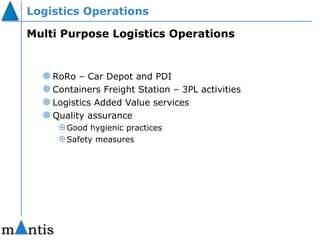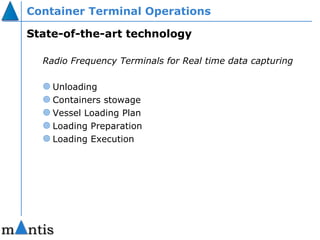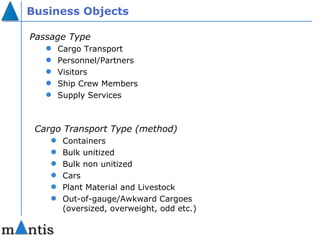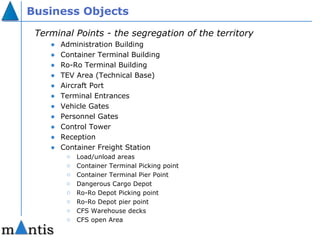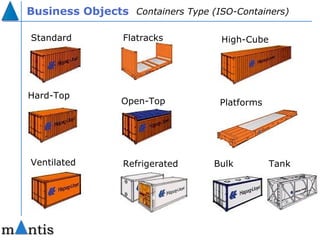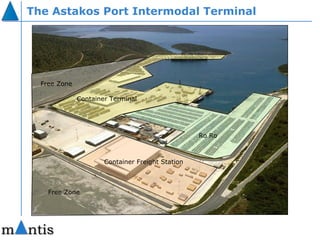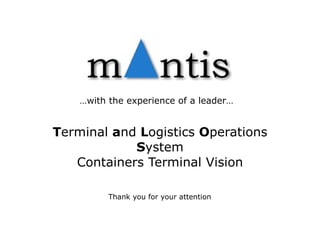Intermodal - Containers Terminal Vision
- 1. Intermodal Terminal & Logistics Operations System ŌĆ” with the experience of a leaderŌĆ”
- 2. Agenda Introduction Gate & Yard management Containers Terminal Operations Logistics Operations Implementation approach
- 3. Introduction Infrastructural Barriers at Terminals Insufficient capacity Lack of space for storage and parking facilities Unsuitable rail infrastructure Insufficient rail and road access Limited flexibility of infrastructure Tidal impact of sea side terminal access Operational Barriers at Terminals Too long waiting times Ineffective information flow Poor real-time monitoring of operations Communication problems/inefficiencies Inefficient internal administrative processes
- 4. Introduction Operational Barriers at Terminals (cont) Insufficient security management Missing or insufficient management of incoming traffic Organizational Barriers at Terminals Missing cooperation between terminal operators and other parties Unsuitable form of terminal organization Low level of information integration among port community Economical Barriers at Terminals High Terminal investment costs High Terminal operation costs Missing added value services at terminals
- 5. Introduction Containers Terminal Vision approach Intuitively Simple Multi purpose Logistics operations management State-of-the-art technology Real time Operations Visualization Information visibility to all parties (Web) Electronic Data Interchange (Resource Management) ŌĆ” and moreŌĆ”ŌĆ”
- 6. Gate & Yard Management Intuitively Simple Single form approach for Unplanned arrivals Scheduled arrivals Resource Appointments recording Access security handling Services reporting Book logging (mainly for vessels)
- 7. Gate & Yard Management Single form approach for Employ Entry & Exit procedure Track Scheduled arrival Vessel/Train Scheduled arrival Book logging (mainly for vessels)
- 8. Logistics Operations Multi Purpose Logistics Operations RoRo ŌĆō Car Depot and PDI Containers Freight Station ŌĆō 3PL activities Logistics Added Value services Quality assurance Good hygienic practices Safety measures
- 9. Container Terminal Operations State-of-the-art technology Radio Frequency Terminals for Real time data capturing Unloading Containers stowage Vessel Loading Plan Loading Preparation Loading Execution
- 10. State-of-the-art Information Technology Platform The experience of a leaderŌĆ”. Workforce Supervision Yard Operations Visualization Operations Performance Monitoring Managerial Information System Business Intelligence powered by Business Objects Web information sharing Electronic Data Interchange Third Party Optimization solutions interfacing .Net Microsoft Oracle DB MS SQL
- 11. Business Objects Means of Transport Vehicle Ship/barge Aircraft Train Individuals Personnel Visitors S hip repairer personnel S ub-contractors P ublic authoritiesŌĆÖ Companies Shippers Exporters Shipping companies Cargo owners Consignors Consignees Underwriters Cargo Brokers Ships Brokers
- 12. Business Objects Passage Type Cargo Transport Personnel/Partners Visitors Ship Crew Members Supply Services Cargo Transport Type (method) Containers Bulk unitized Bulk non unitized Cars Plant Material and Livestock Out-of-gauge/Awkward Cargoes (oversized, overweight, odd etc.)
- 13. Business Objects Terminal Points - t he segregation of the territory Administration Building Container Terminal Building Ro-Ro Terminal Building TEV Area (Technical Base) Aircraft Port Terminal Entrances Vehicle Gates Personnel Gates Control Tower Reception Container Freight Station Load/unload areas Container Terminal Picking point Container Terminal Pier Point Dangerous Cargo Depot Ro-Ro Depot Picking point Ro-Ro Depot pier point CFS Warehouse decks CFS open Area
- 14. Business Objects Container properties Container Number (ISO 6346) Type (ISO-Containers) Size (20 ft, 40 ft, 45ft, 45 ft, 48 ft, 53 ft) Container Owner Status (Loaded, Empty) Physical Condition (Suitable, Flaw, Not defined) Date Manufactured Registration Country Container comments Seal Number Customs State (Import, Export, Domestic, Transit) Plugged Status (Plugged-In, Unplugged) for Reefer only Attached A/D notification number (for retrieving information such as Shipper/exporter, mean of transport, arrival date etc.) TEU factor (a number that indicates the measure of the container in TEU)
- 15. Business Objects Standard High-Cube Hard-Top Open-Top Flatracks Platforms Ventilated Refrigerated Bulk Tank Containers Type (ISO-Containers)
- 16. Business Objects Container cargo Properties Cargo Owner Cargo Package Type Cargo package quantity IMO Class (For dangerous cargoes) Net explosive Weight (For IMO class : explosives) IMO remark Cargo Description Code (The cargo descriptions will be registered encoded into the system) Cargo description Container Metric Properties External dimensions (Length, Width, Height) Interior dimensions (Length, Width, Height) Door aperture (Width, Height) Volume Tare weight Gross Weight
- 17. Business Objects IMO Class (classification for dangerous Goods)
- 18. Implementing CTV to Akarport The Case of Astakos Port Bi-modal Terminal (Road ŌĆō Sea Transshipment) Multipurpose Logistics Park Containers Terminal Containers Freight Station Car Depot Free Zone administration Fast Solution Implementation
- 19. The Astakos Port Intermodal Terminal
- 20. The Astakos Port Intermodal Terminal Container Terminal Ro Ro Container Freight Station Free Zone Free Zone
- 21. The Astakos Port Intermodal Terminal
- 22. The Astakos Port Intermodal Terminal
- 23. State of the art technology monitoring performance
- 24. Implementing CTV to Akarport The Case of Astakos Port RF Operations execution with ŌĆ£smart containers identificationŌĆØ Gate Security Smart Cards with multi purpose use Additional Services Tracing Services Billing Calculations Operations Real Time Monitoring Cost effective reliable solution Total Customer Satisfaction
- 25. T erminal a nd L ogistics O perations S ystem Containers Terminal Vision Thank you for your attention ŌĆ” with the experience of a leaderŌĆ”
Editor's Notes
- Passage Type - The categorized purpose for anyone crossing the entry points of free zone inward or outward
- Some of these points will be destination areas for loaded means of transport with cargo. Furthermore itŌĆÖs possible in each terminal point to have assigned specific system users for security reasons and for easy system login procedure. (When the user log into the system he should enter the terminal point on which he was been assigned for work. If the user is already linked into a specific terminal point then this terminal point will be selected automatic by the system.)








